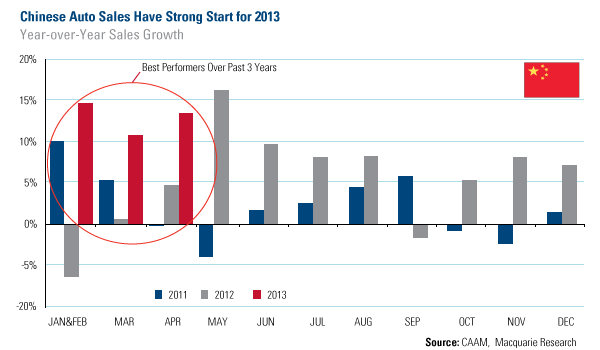Energy and Natural Resources Market Radar (May 27, 2013)
Strengths
- Natural gas futures gained for the second consecutive week, up over 3 percent, as a smaller-than-expected injection into storage boosted prices.
- Soybeans advanced to a six-month high, heading for the best run in more than a year, on signs that demand will increase in China even as U.S. supplies shrink. Soybeans for July delivery gained as much as 0.6 percent to $15.025 a bushel, the highest for a most-active contract since November 8, on the Chicago Board of Trade. China’s soybean imports, the world’s largest, will start increasing sizably from this month onward and jump 17 percent in the next season, according to Oil World.
- According to Deutsche Bank, U.S. seaborne thermal coal exports in the first quarter increased to 11.3 million tons from 9.4 million tons last year, despite better competitiveness of coal for power generation. A domestic oversupply of coal is likely to become a larger problem as more coal-fired power generation is closed in coming years as a result of anti-pollution legislation. The construction of West coast ports capable of handling coal is a key uncertainty as they face opposition from environmental and local interest groups. While three projects have been cancelled in the last year, two of the largest projects backed by coal producers are still in the planning process, holding out hope of opening a gateway for U.S. coal to the Pacific Basin.
- China imported 32.28 million tons of iron ore from Australia in April, up 27 percent year-on-year and up 0.3 percent from March, data released Wednesday by the General Administration of Customs showed. Australia remained the top supplier of iron ore to China, accounting for 48 percent of total imports in April, compared with 50 percent in March. A Singapore-based trading source attributed the increase to more availability of Australian cargoes in the spot market. China's demand for steel products climbed in April as more construction projects gained traction on warmer weather.
Weaknesses
- Crude oil, copper and several industrial commodities fell this week after weak economic data was released out of China. HSBC-Markit's China Flash Manufacturing Purchasing Manager’s Index (PMI) fell 0.9 points to a seven-month low of 49.6 in April, pointing to a potential dip in the country's manufacturing output over the next few months. One potential positive for commodities further ahead is that the latest data suggest destocking of inputs into manufacturing continued, and at an accelerating rate in April, which cannot carry on indefinitely.
Opportunities
- The approval of exports to non-Free Trade Agreement (FTA) countries from the Freeport LNG project by the U.S. Department of Energy marks the first such approval since Sabine Pass in May 2011. This brings the approved volume of LNG exports to non-FTA countries from the two projects together to 25 million tons per annum, or 3.6 billion cubic feet (Bcf) per day. Opposition to further approvals will certainly grow louder with each new approval, so the thresholds used in the EIA and NERA export studies (6 & 12 Bcf per day) may serve as opportune pausing points in the approval process as the impact is re-assessed. Next on the list is the Lake Charles project by Southern Union and BG, which would bring the total approved volume to 5.6 Bcf per day, while an additional five projects, in the order of processing, would bring the total to 11.75 Bcf per day,
- Mongolia's parliament finally passed a long-awaited securities law on Friday that will allow the state-owned firm mining the enormous Tavan Tolgoi coal deposit to launch a $3 billion initial public offering at home and overseas. Khangai Altai, the chief executive of the fledgling Mongolian Stock Exchange said the new law would also help attract more companies to the exchange by introducing international standards, adding that it could eventually bring total market capitalization to around $30-$40 billion, from only around $1.3 billion at present.
- Corn sales to China, the world’s second-biggest grower, probably will triple as the government rebuilds inventories with imported grain that now costs less than domestic crops, according to Archer Financial Services. Imported corn has been cheaper than Chinese grain values since April, spurring increased purchases of U.S. supplies. China imports may jump to 10 million metric tons in the year that begins October 1, up from 3 million this year, said Gregg Hunt, a grain analyst at Archer Financial. “There is a growing economic incentive for China to import corn, most of which will come from the U.S.,” said the Chicago-based Hunt, who has been trading commodities for more than 30 years. “The record prices indicate China doesn’t have much corn left from the previous harvest, because of rising feed demand. The government will be looking to replenish supplies with imported corn.”
- India's metallurgical coal imports are likely to grow by 8.7 percent to 35 million tons in 2013-2014 as additions to its steel-making capacity lift demand, four traders and a steelmaker said. India, the world's fourth-largest steel producer, is expected to add around 5 million to 6 million tons of steel-making capacity in this fiscal year to March-end, said an official at JSW Steel.
Threats
- South African power utility Eskom said on Thursday that the reserve margin between forecast demand and capacity in the evening was only 132 megawatts, or less than 0.4 percent of available power. Eskom is battling to keep the lights on in Africa's largest economy with the approach of the southern hemisphere's winter. Earlier in May, the national grid came within a hair's breadth of overloading, when the gap between demand and supply was only 0.06 percent.
- Australian coal miners are steeling themselves for years of production cuts, job reductions and asset sales as swelling shipments from international rivals lower hopes of a recovery in prices for coal. Prices have slumped around 30 percent since their peak two years ago as coal flooded global markets, especially from the United States where cheap gas has cut domestic demand and led to a nearly 50 percent jump in thermal coal exports last year. Even robust Chinese and Indian demand growth is failing to soak up the plentiful supply
- Serious overcapacity in China's steel industry is unlikely to ease in 2013, which could hamper steel prices and jeopardize Chinese steelmakers' performance, a China-based analyst said Thursday. China is set to produce about 750 million metric tons of crude steel in 2013, while capacity will rise to 950 million tons a year, as some 50 million tons new capacity is being built, said Jing Zhang, an analyst with Platts, during the company's Steel Markets Europe congress. This will bring the country's overcapacity to around 200 million tons, she said. "Any demand recovery or price rebound during the rest of the year could easily trigger a production jump which could in turn hamper steel prices and jeopardize Chinese steelmakers' performance," Ms. Zhang said. “Seventy percent of Chinese steelmakers lost money in April and May."













